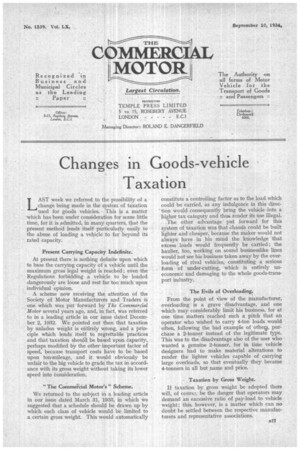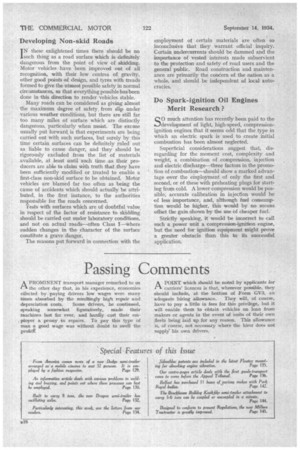Changes in Goods-vehicle Taxation
Page 27

Page 28

If you've noticed an error in this article please click here to report it so we can fix it.
LAST week we referred to the possibility of a change being made in the system of taxation used for goods vehicles. This is a matter which has been under consideration for some little time, for it is admitted, in many quarters, that the present method lends itself particularly easily to the abuse of loading a vehicle to far beyond its • rated capacity.
Present Carrying Capacity Indefinite.
At present there is nothing definite upon which to base the carrying capacity of a vehicle until the maximum gross legal weight is reached ; even the Regulations forbidding a vehicle to be loaded dangerously are loose and rest far too much upon individual opinion.
• A scheme now receiving the attention of the • Society of Motor Manufacturers and Traders is one which was put forward by The Commercial Motor several years ago, and, in fact, was referred to in a leading article in our issue dated December 2, 1932. We pointed out then that taxation by unladen weight is entirely wrong, and a principle which lends itself to regrettable practices and that taxation shoula be based upon capacity. perhaps modified by the other important factor of speed, because transport costs have to be based upon ton-mileage, and it would obviously be unfair to the big vehicle to grade the tax in accordance with its gross weight without taking its lower speed into consideration.
"The Commercial Motor's" Scheme.
We returned to the subject in a leading article in our issue dated March 31, 1933, in which we suggested that a schedule should be drawn up by which each class of vehicle would be limited to a certain gross weight. This would automatically constitute a controlling factor as to the load which could be carried, as any indulgence in this direction would consequently bring the vehicle into a higher tax category and thus render its use illegal. The other advantage put forward for this system of taxation was that chassis could be built lighter and cheaper, because the maker would not always have in his mind the knowledge that excess loads would frequently be carried ; the haulier, too, working on sound businesslike lines would not see his business taken away by the overloading of rival vehicles, constituting a serious form of under-cutting, which is entirely uneconomic and damaging to the whole goods-transport industry.
The Evils of Overloading.
From the point of view of the manufacturer, overloading is a grave disadvantage, and one which may considerably limit his business, for at one time matters reached such a pitch that an operator who wished to carry 4-ton loads would often, following the bad example of othew, purchase a 2-tormer instead of the legitimate type. This was to the disadvantage also of the user who wanted a genuine 2-tonner, for in time vehicle designers had to make material alterations to render the lighter vehicles capable of carrying large overloads, so that eventually they became 4-tonners in all but name and price.
Taxation by Gross Weight.
If taxation by gross weight be adopted there will, of course, be the danger that operators may demand an excessive ratio of pay-load to vehicle weight ; this, however, is a matter which can no doubt be settled between the respective manufacturers and representative associations.
Developing Non-skid Roads
IN these enlightened times there should be no such thing as a road surface which is definitely dangerous from the point of view of skidding. Motor vehicles have been improved out of all recognition, with their low centres of gravity, other good points of design, and tyres with treads formed to give the utmost possible safety in normal circumstances, so that everything possible has been done in this direction to render vehicles stable. Many roads can be considered as giving almost the maximum degree of safety, from slip under various weather conditions, but there are still far too many miles of surface which are distinctly dangerous, particularly when moist. The excuse usually put forward is that experiments are being carried out with such surfaces, but surely by this time certain surfaces can be definitely ruled out as• liable to came danger, and they should be rigorously excluded. from the list of materials available, at least until such time as their producers are able to claim With truth that they have been sufficiently modified or treated to enable a first-class non-skid surface to be obtained'. Motor vehicles are blamed far too often as being the cause of accidents which should actually he attributed, in the first instance, to the authorities responsible for the roads concerned. Tests with surfaces which are of doubtful value in respect of the factor of resistance to skidding should be carried out under laboratory conditions, ss and not on actual roads—often Cla —*here sudden changes in the character of the surface constitute a grave danger, The reasons put forward in connection with the employment of certain materials are often so inconclusive that they warrant official inquiry. Certain undercurrentsshould be dammed and the importance of vested interests made subservient to the protection and safety of road users and the general public. Road construction and maintenance are primarily the concern of the nation as a whole, and should be independent of local autocracies.
Do Spark-ignition Oil Engines Merit Research ?
QO much attention has recently been paid to the t3development of light, high-speed, compressionignition engines that it seems odd that the type in which an electric spark is used to create initial combustion has been almost neglected. Superficial considerations suggest that, disregarding for the moment cost, complexity and weight, a combination of compression, injection and electric discharge three factors in the promotion of combustion—should show a marked advantage over the employment of only the first and second, or of these with preheating plugs for starting from cold. A lower compression would be possible, accurate calibration in injection would be of less importance, and, although fuel consumption would be higher, this wonki by no means offset the gain shown by the use of cheaper fuel. Strictly speaking, it would be incorrect to call such a power unit a compression-ignition engine, but the need for ignition equipment might prow a greater obstacle than this to its successful application.




















































































